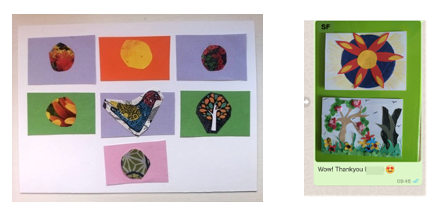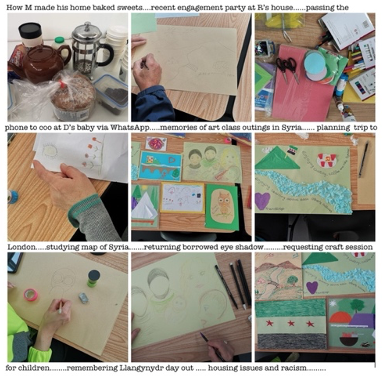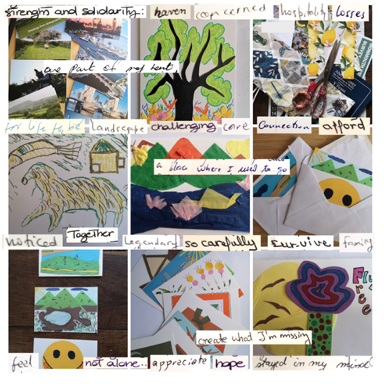I am researching practices of welcome for refugees and asylum seekers in rural Wales – which often centre on activities such as cooking, walking, dancing, events, and outings. It looks at how people encountering each other through these groups, connect across very different experiences of migration and of language, and very different senses of familiarity with being in rural Wales, and how they make meaning and tell stories around migration, welcome and belonging through the activities they participate in.
I am exploring the idea of seeing these activities as ‘literacies of doing’ and how this relates to language understood by Pennycook, Simpson and others as a social participation. I’m interested in how communicative repertoires of both spoken and unspoken language, are assembled in improvised and creative ways and how this can shift away from the dominance of English language seen as a fixed entity, and competence in it used as signifier of belonging and test for citizenship. As the study progresses, ideas around language seem to be as significant in the research practices as they are in the encounters of welcome themselves, and so I’ve become interested in the interplay between the two.
For one case study I re-connected with some participants for a project based on their experiences of staying in a domestic, home environment here in a village in rural Wales. As we couldn’t meet, we created and exchanged postcards. Postcards worked as small, easily available, mobile objects carrying meaning through a combination of image and a short chunk of text, enabling people with a wide range of language and literacy skills in English to participate. I was struck by Pennycook (2010) using the example of writing a postcard to elaborate on the idea of language as a social practice, as ‘a set of bundled activities There is the obvious moment of writing the card – but it’s also about images, feelings, knowledges, memories, anticipations, connections between people and ‘multifaceted relations to place’ (Pennycook 2010 p3).

Other communicative practices grew around the postcard exchange – a WhatsApp group and a creative card making Zoom session enriched the repertoire of resources available for a shared language of participation. Boundaries between spoken, written and visual language, working with technology and with paper, being in physical and digital space, were broken down as people seemed to combine and switch frequently and easily between them. The card I made was of the Zoom screen.
There was something, for me, particularly affecting about the material aspect of the postcards, the textures, the mark making, the packing and unpacking and the unexpected intimacy of handwritten text. As these objects moved between us they narrated our experience in a different mode to the immediacy of spoken dialogue. There were pauses while we waited for a reply, time to dwell on cards received and consider our response. We had a chance to say things that we didn’t say at the time of the encounters we shared.

The current phase of research is with a local Town of Sanctuary group I’m involved with. Conversation Café is a weekly meet up originally organised as a space for families resettled here to practice their English. Two of these sessions were used to do some making with images and text, based around people’s experiences of the Town of Sanctuary activities. I guess I was mistakenly hooked on what would be produced, while actually, what was happening in the room around the making was what I needed to pay more attention to. As Hawkins puts it – ‘sitting with the process rather than the output’.

The collage on the left shows pics of the making and some of the finished work, but threaded between the images, I’ve noted the live conversations and actions running through the practice as, rather than incidental, these seem just as significant as the images that we were aiming to produce.
Without trying to make it fit too neatly, I would say that some of the creative research methods and experiences echo what happens in the interactions of welcome which are the focus of the research. The assembling of improvised communicative repertoires of spoken and unspoken language through creative practices of ‘doing’ takes place in both. Some of the ideas that circulate around both are to do with the way connections and meanings are formed through a mix of deliberate and improvised activities and the significance of the incidental as well as the planned. This links to questions around how stories emerge from practices that are more organised, controlled, and reflective or more chaotic, immediate and spontaneous. So, when thinking about ways in which narratives about migration welcome and belonging are created through practices of welcome, it seems important to pay attention to what has come up through the process, not just the results.
Overall, I’m looking for ways to piece things all altogether. I’m drawn to using fragments, mosaics, patchwork; intersected or layered with language. I think this also reflects what happens more generally in the encounters of welcome themselves, not just this research context – the spaces where spoken and unspoken language practices blend in small scale, quite transient fragments of people’s lives.

This collage is one I made from some of the material produced in the postcard project with fragments from the text overlaying the images. I’m hoping to assemble the collection of cards from this project into a small mobile exhibition, firstly here in the village hall in Llanvapley. I’ve found myself thinking ahead to how they could be arranged or assembled – thematically, or as conversations. I considered whether to indicate the authors of the cards as refugees, other transnational migrants, volunteers, workers, researcher, or combinations thereof or leave them completely uncategorised. This visual and spatial thinking has been helpful in considering how to talk and write about the project – to narrate the human stories circulating around the cards as artefacts. Trying to find ways to let the cards speak for themselves but also extend the conversation through engaging with theory and scholarship around mobilities, welcome, belonging, and rurality. But obviously I need to shape things into a PhD study too, so I guess I’m also looking for a suitable language practice and communicative repertoire myself, in order to do that, and to do justice to what participants have produced.
Bibliography
Hawkins, H. (2019) Geography’s creative (re)turn: Towards a critical framework. Progress in Human Geography 43(6) 963-984
Pennycook, A. (2010) Language as a Local Practice Routledge, Oxon, NY
Pennycook, A. (2012) Language and mobility: Unexpected places. Multilingual Matters Bristol, Buffalo, Toronto
Simpson, J. (2015) English language learning for adult migrants in superdiverse Britain. In James Simpson & Anne Whiteside (Eds) Adult Language Education and Migration Challenging agendas in policy and practice Ch 15 200-2013 Routledge, NY and Oxon